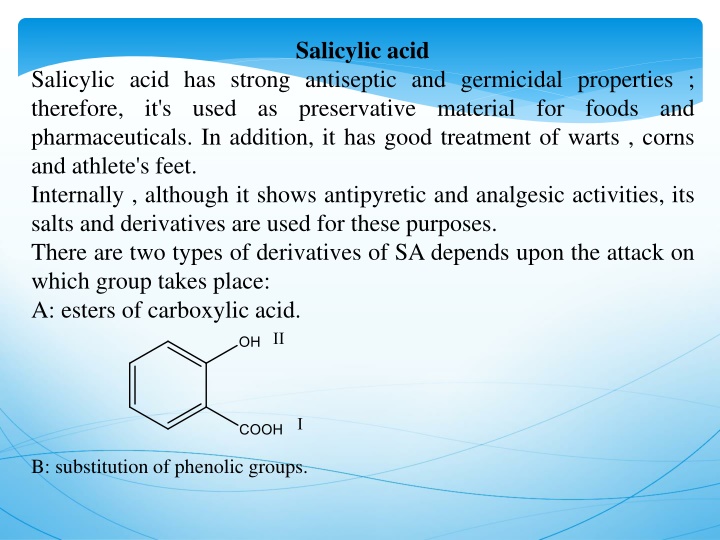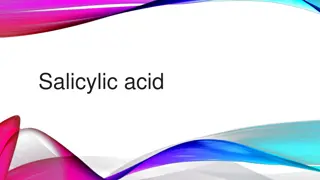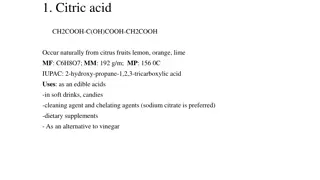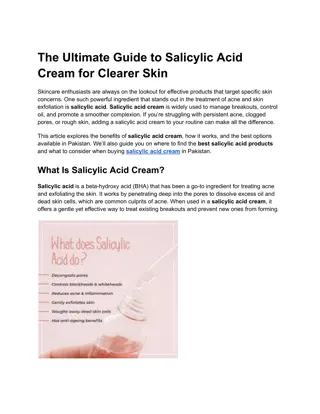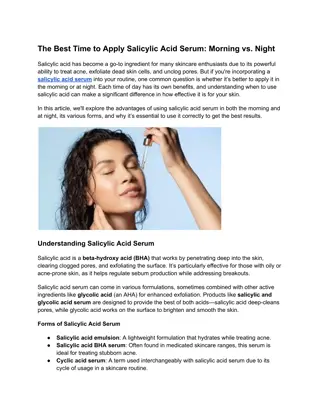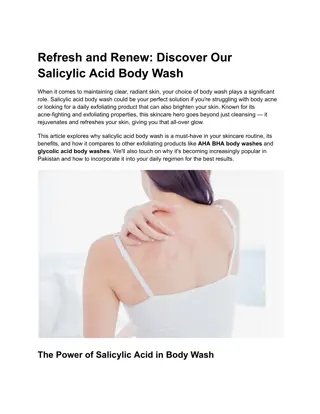Overview of Salicylic Acid and its Derivatives
Salicylic acid is known for its antiseptic, germicidal, and analgesic properties, used in various applications such as preservatives, wart treatments, and pain relief. Different derivatives of salicylic acid are developed to minimize side effects and enhance efficacy. Acetyl salicylic acid (ASA), commonly known as aspirin, is a popular derivative with improved tolerability and effectiveness. The article discusses the differences between salicylic acid and ASA, highlighting their uses and properties in the pharmaceutical industry.
Download Presentation

Please find below an Image/Link to download the presentation.
The content on the website is provided AS IS for your information and personal use only. It may not be sold, licensed, or shared on other websites without obtaining consent from the author.If you encounter any issues during the download, it is possible that the publisher has removed the file from their server.
You are allowed to download the files provided on this website for personal or commercial use, subject to the condition that they are used lawfully. All files are the property of their respective owners.
The content on the website is provided AS IS for your information and personal use only. It may not be sold, licensed, or shared on other websites without obtaining consent from the author.
E N D
Presentation Transcript
Salicylic acid Salicylic acid has strong antiseptic and germicidal properties ; therefore, it's used as preservative material for foods and pharmaceuticals. In addition, it has good treatment of warts , corns and athlete's feet. Internally , although it shows antipyretic and analgesic activities, its salts and derivatives are used for these purposes. There are two types of derivatives of SA depends upon the attack on which group takes place: A: esters of carboxylic acid. B: substitution of phenolic groups.
Most of these derivatives are introduced to minimize the gastric disturbances, hemorrhage irritation and undesirable taste. The advantage of these derivatives is to increase the effects and decrease side effects. Examples: 1. Ammonium salicylate.(H.W) 2. Sod. Salicylate .(H.W) 3. Methyl salicylate.(H.W) 4. Ethyl salicylate . 5. Strontium salicylate (sod. Salicylate+bismuth nitrate) .(H.W) 6. Salicylamide.(H.W) 7. Salysal (ester linkage between two molecules of SA sal- ester-sal)
8.Salol. 9.Acetyl salicylic acid.(H.W)
Salicylic acid and acetyl salicylic acid: Salicylic acid was a good analgesic and antipyretic, but it has an unwanted teste and an irritating effect on the stomach, people could not tolerate taking SA. SA was treated with acetic anhydride in the presence of H2SO4 to give acetyl salicylic acid (ASA), this compound is known as aspirin tested as better and much less acidic than SA; so that the patient could tolerate taking aspirin by mouth.
Aspirin possesses a NO. of properties that make it the most often recommended drug 1. It is analgesic, effective in relieving headache pain. 2. It is anti-inflammatory agent providing some relief form the swelling associated with arthritis and minor injuries. 3. It is antipyretic agent, it reduces fever 4. Recently it is used as prophylaxis of heart attack
Differences between SA and ASA: 1. SA gives +ve result with ferric chloride FeCl3 because it contains free OH gp., while ASA give ve result because (OH) gp. Of SA is acetylated to give ASA.
2. SA can not be used internally because it causes stomach irritation while ASA is less irritating. 3. Melting point of SA differs from that of ASA. 4. Salicylate anion is stabilized by intramolecular H bonding; therefore, SA is more slightly soluble in water than ASA (SA<ASA).
Preparation of salicylic acid: Industrial method: 1. Kolbe's reaction:
The OH gp. Strongly activates the aromatic ring towards electrophilic attack . electron delocalization of phenoxide anion leads to increase electron density at the position of ortho and para to oxygen ( resonance structures). The increased nucleophilicity of the ring permits it to reacts with carbon dioxide, an intermediate is formed which is keto form of salicylate anion.
Lab. Method ( alkaline hydrolysis of ester ): SA is prepared from methyl salicylate by hydrolysis of ester group with aqueous alkali (NaOH or KOH)
The mechanism : 1. Nucleophilic addition of OH- ion to the carbonyl gp: 2. Proton transfer to anionic form of tetrahedral intermediate:
Procedure: 1. Place 5g of oil of methyl salicylate (0.1 g of wintergreen ) in a 250 ml distilling flask together with 50 ml of 20% (w/v) aq. sol. Of NaOH. 2. Mix well, the sod. Salt of methyl salicylate phenolic gp may separate out at this point, but will redissolve on heating. 3. Reflux at the boiling point for 15-20 min. 4. Transfer the mixture to a 125-ml beaker, cool and acidify with dil. H2SO4 (check acidification by litmus paper). 5. Filter the precipitated SA with suction and dry. 6. Recrystallize from the minimum amount of hot water and weigh the pure SA (white crystals). (MP=165-167 )(M Wt = 138 g/mol).
